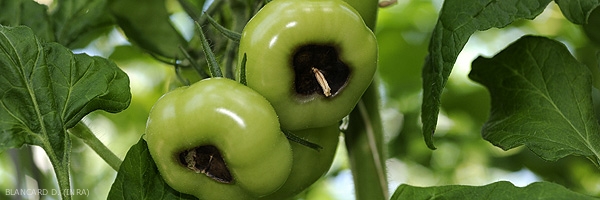
Blossom end necrosis on fruits
( blossom-end rot )
- Symptoms on fruits
Development at the ends of the fruits, at or near the pistillate attachment, of small moist lesions, quite diffuse at first, turning brown and gradually extending thereafter (figure 1). Ultimately, a large brownish to black deterioration, more or less concave and well defined, of rather dry consistency, depreciates the apical end of one or more fruits (figures 2 and 3). This symptom is also trivially referred to as “ black ass ” by producers (Figures 4 to 5).
Essentially internal browning of a few seeds and a more or less important portion of the placenta located in the pistillate part of the fruits . This internal lesion can sometimes take on the appearance of a corky fibrous mass. This internal necrosis would correspond to a little evolved or attenuated form of classic apical necrosis.
This physiological disorder is commonly observed in all types of crops, especially in those that are irrigated with furrows, by submersion, or in amateur gardeners using the garden hose. It can appear at all stages of fruit development, but it occurs mostly when the fruit is one third or one half of its maximum size. Tomatoes affected by blossom end necrosis are often the first to form, which ripen faster. Note that this lesion can be colonized by various microorganisms, secondary invaders, responsible for the rots described in this chapter (figure 3) (in particular Alternaria ).
Ferti-irrigation
- Origin of damage
Non-parasitic disease
This condition is linked to a lack of calcium in the distal part of the fruits following a lack of absorption of this element by the roots or its insufficient transport via the raw sap in the xylem.
Several parameters can explain these two situations:
- a true calcium deficiency or an antagonism of this element with other elements of the soil or of the nutrient solution (NH 4 + , NO 3 - , Mg ++ );
- high salinity induced by insufficient watering or high electrical conductivity of the nutrient solution, limiting the absorption of calcium;
- heavy sweating;
- too rapid growth of plants and fruits;
- a root system limited naturally or following the development of lesions of biotic origin (root pests) or abiotic (poorly prepared soil, tillage mutilating the roots, root asphyxiation ), this reducing the absorption of l 'water and calcium (see topic Root Asphyxia );
- insufficient or poorly distributed irrigations over time causing excessive fluctuations in soil moisture.
In addition to these previous factors, blossom end necrosis is particularly evident during and following hot and dry climatic periods. - How to cure it
Provide maximum comfort to the plants.
The climate
- Ensure optimal humidity in shelters and limit plant transpiration as much as possible (bleaching or sprinkling of roofs).
- Avoid subjecting plants to hot, dry wind.
Ferti-irrigation
- Ensure balanced fertilization (avoid excess, especially in nitrogen) and optimal calcium intake.
- Above ground, enrich the nutrient solution with PO 4 H 2 - and Cl - , these two elements promoting calcium absorption.
- In soil, maintain an adequate level of phosphorus, especially when planting, and a soil pH of between 6.5 and 6.8.
- Avoid excessive salinity.
- Foliar applications of anhydrous calcium chloride are recommended in the United States.
The plant and its behavior
- Cultivate varieties that are not very sensitive.
- Carry out regular leaf stripping in order to maintain a good balance with the fruit load.
- Mulch the soil in order to maintain a more constant humidity.
- Avoid mutilating the roots during soil maintenance operations.





